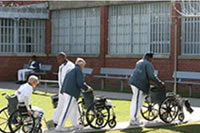 The past four decades have brought about the most sustained and widespread imprisonment in human history. The United States represents 5% of the world’s population, yet it is responsible for 25% of the world’s incarcerated population. With 2.3 million inmates, the U.S. beats all other countries in terms of the overall prison population and incarceration rates per capita.
The past four decades have brought about the most sustained and widespread imprisonment in human history. The United States represents 5% of the world’s population, yet it is responsible for 25% of the world’s incarcerated population. With 2.3 million inmates, the U.S. beats all other countries in terms of the overall prison population and incarceration rates per capita.
Significant costs of incarceration have sparked debate about reducing the prison population as a matter of fiscal and budgetary necessity. With the prison population aging, the costs associated with incarceration and care will soon spiral out of control. Despite the fields of gerontology, medical and mental health, philanthropy, and corrections having a common interest in the issue, they have only addressed it intermittently and never acted with a unified voice. For the problem to be resolved there needs to be multi-sector dialogue, cross-pollination of ideas, and a shared foundational knowledge that will strengthen the interconnectedness of these fields and act as a platform for unified action.
The Osborne Association finds that austerity-driven policies and public discomfort with mass incarceration create an opportunity to solve the problem of the graying prison population and make the criminal justice system more humane, cost-effective and socially responsible.
Read more in the full paper at osborneny.org![]()
